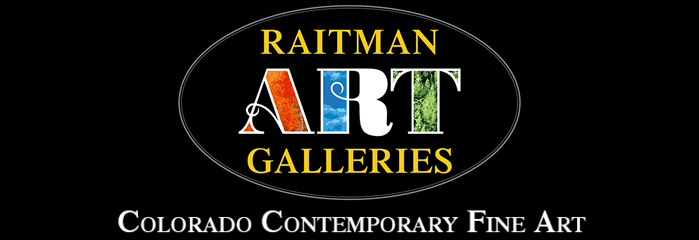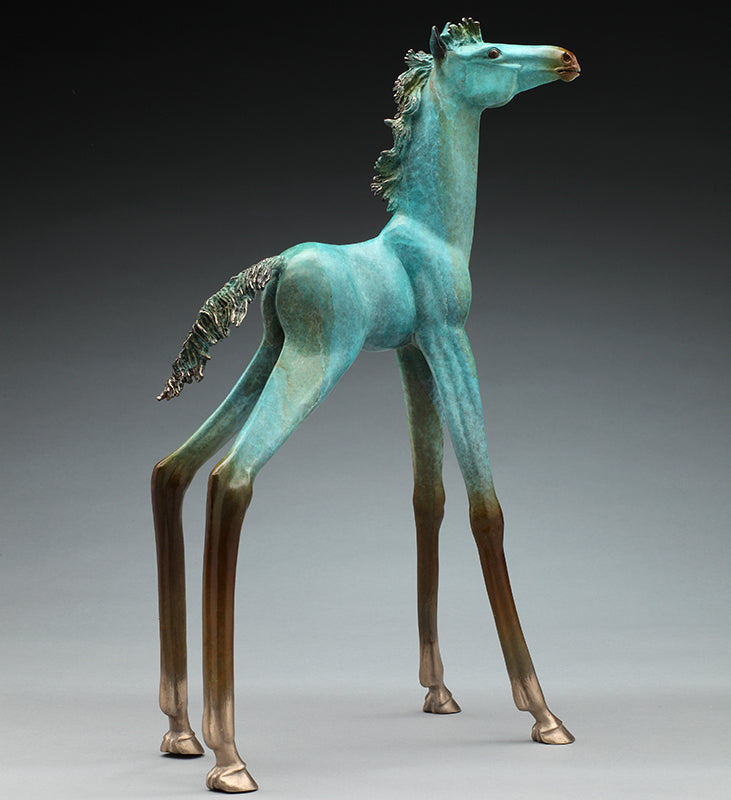Alex Alvis Artist Review
History
Humans and horses have a long history together, and as such equine imagery can be found in artwork throughout time. In fact some of the most ancient art-forms depict horses. The Lascaux Cave paintings discovered in France date back 20,000 years and feature horses, hunters, and bison. One can categorize artwork that depicts horses as equestrian if there is a rider present, and equine if no rider is present.

Horse Cave Painting
Lascaux, France
At the forefront of American West equine and equestrian sculptures and paintings was Fredrick Remington. Fredrick’s paintings and bronze sculptures of the American West and cowboy culture captured the spirit of the Wild West and the horses that took us there. In his sculptures the dynamic forms of the horse and rider are pivotal in the action, tension and the movement they posses. Traditionally horses have been depicted as service animals who are present due to their utility for man and were very rarely depicted without a visible human connection.

Rattlesnake, 1905
Fredrick Remington
Alex Alvis has a contemporary take on the horse and it’s place in the art world. The first noticeable difference from the traditions of equine sculpture is the lack of any human presence. Alex, who grew up alongside the companionship of horses, sees beyond a horse’s utility to their spirit. It is the wild, free, and complex personalities of her equine friends that inspire her.
Another noticeable difference is the elongated legs that characterizes Alex’s sculptures. This whimsical feature of her sculptures offers the viewer an insight into the feeling one gets when interacting with a horse, that their legs could take them anywhere and into infinity. The dreamy and fanciful feel offers a nod to surrealism, which is characterized by infusing irregularity into the normal.
Alex uses the same traditional lost wax casting method as Fredrick Remington and the many artists that came before them (we will discuss the process in depth in the production portion of this paper). Yet she differentiates her work from traditional bronze sculptures through her unique patina work. This colorful surface detail modernizers Alex’s sculptures and makes each sculpture unique and different.
Aesthetics
Principals of Art:
Space: Alex’s sculptures utilize space in two important ways. The positive space of the forms of the sculpture, and negative space which pertains to the spaces in between and around the sculpture. In many ways the space the sculptures make around them can be just as beautiful as the space the bronze itself creates. In Step High the horse creates space between it’s elongated legs which creates not only depth, but a sense of movement. The beauty of sculpture is that the use of space is a 360 degree experience with every angle offering a new view of the spaces created.
Color: Color is an important aspect of Alex’s work and is created with patinas that are applied directly to the surface of the bronze sculpture. Although it is painted on, a patina does not paint a piece but rather changes the chemical composition of the surface of the bronze. In “Step High” Alex uses bright and surreal colors which adds to the whimsy she creates. Every patina is spontaneously unique and makes every bronze a one of a kinds.
Shape: The shapes that piece together Alex’s sculptures range from soft undulating curves, to sharp angles that changes the direction of the form. The use of shape can also be found in the shapes created in the negative surrounding space, for example the open triangular shape created between Step High’s front legs.
Form: Circle is to shape as sphere is to form. Sculpture offerers the viewer form in the truest sense due to sculpture being three dimensional. The form of Alex’s sculptures is representational in that it is a clear depiction of a horse, yet non representational in its divergence from reality. The forms in Alex’s sculptures also speak to the mood and feel of each piece. A downward head, extended legs, leaping or laying down, all the forms her sculptures take reflect the mood she is conveying to the viewer.
Value: Value relates to the tint/shade of a hue (color). Every color can be tinted by adding white or shaded by adding black. The purpose of considering value in a work of art is to help create both dimension and a mood. In Alexandra’s sculptures, the difference in value is created in the darkening and lightening of the patina. In Step High you can see how Alex varies the dark and light colors around the horse to create visual movement and an idea of how shadow would fall on the form.
Texture: Alex favors a smooth finish to her bronzes with very little texture. The smooth surface of the body produces a reflective and polished surface that is beautiful in both sight and touch. Texture can be found in the horses mane and tail, which creates movement and action to the sculpture and juxtaposes against the smooth finish of the body.
Principals of Design:
Balance: Alex often creates a sense of teetering balance, the form itself seems to be caught in a fleeting moment of time, balanced between this moment and the next. In Step High the visual weight of the sculpture is balanced between the front and rear of the horse. The visual weight of the neck and front legs is counterbalanced by the rear legs and tail. The front of the horse has slightly more visual weight, which keeps the balance from being halved and keeps the eye moving forward as the piece suggests.
Unity: The unity of a piece is what creates a sense of completeness. The colorful patina and cohesive texture gives the sculptures a harmonious flow that unites the entire piece.
Variety: Variety is what adds interest into a work of art. Two main factors that give Step High variety are the texture and color use. The texture change of the smooth surface to the rough hair makes them juxtapose against one another. The changes in color from the golden hooves, to the varieties green and red tones and the black mane all offer the eye something new and fun to observe.
Emphasis: Emphasis is what the artist uses to create a focal point. Focal points can vary viewer to viewer, but a truly successful composition will have one clear focal point that the eye is continually drawn to over and over again. It can be a challenge to find one noticeable focal point in a sculpture, as the sculpture itself acts as it’s own focal force. In Alex’s sculptures, the fanciful and fun elongated legs are what draws the viewer in time and time again.
Movement: Movement implies motion is a snapshot of time. All of Alex’s sculptures capture this idea, a moment of stillness in an active and ever moving creature. In Step High we observe a horse ready to take it’s next step forward, leading us to the questions, what’s next?
Pattern: Think of pattern as the visual skeleton that organizes the parts of a composition. This underlying structure uses consistent and regular repetition. You can have both natural and man made pattern. Pattern can be found in the natural repetition of the horse’s legs in Alex’s sculptures. This subtle and organic pattern is expected, but still visually pleasing to the eye. .
Perspective: Perspective in sculpture is in the eye of the viewer. As the viewer walks around Step High their perspective changes the appearance of the piece. Viewing the sculpture from any new angle offers the viewer an entirely different perspective into the same work of art.
Production
Alex uses the lost wax casting technique which has been in use for the last 6,000 years in the production of bronze sculpture. The process starts with making the model in clay, wax or a similar medium. Once the form has been created a mold is made around it so the interior of the ridged outer mold holds a mirror image of the original mold in it’s interior. After the mold is completed it is filled with molten wax which creates a hollow wax copy of the original mold. The wax mold is then “chased” where it is finished to look just like the original mold. This wax copy is then “spurred” with a tree like structure of wax which will act as a guide for the molten coating material and then melted away. Once the wax copy has been spurred, it is then dipped into a slurry of silica which acts like a sand coating the entire exterior of the wax copy. This silica coated piece is placed in a kiln, spurred down, and the heat hardens the shell and the wax melts out. Now all that remains of the original artwork is the negative space formerly occupied by the wax, inside the hardened ceramic shell. Bronze is melted in a furnace then poured into the shell and then allowed to cool. The shell is either sand blasted or hammered away revealing the rough casting. Metal chasing now smooths the edges, removes imperfections, and clips off the spurs to reveal the same mold in its finished bronze form. The patina is then painstakingly applied by the artist typically with a paint or air brush.
.



